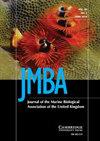观赏虾 Lysmata ankeri(十足目:鲤形目)早期卵巢阶段的营养脆弱性
IF 0.9
4区 生物学
Q3 MARINE & FRESHWATER BIOLOGY
Journal of the Marine Biological Association of the United Kingdom
Pub Date : 2024-04-22
DOI:10.1017/s002531542400033x
引用次数: 0
摘要
评估早期饥饿和摄食对观赏性海水卡氏对虾生命周期早期阶段的存活和生长的影响,是在其养殖过程中制定适当喂养方案的基础。在这项研究中,我们测定了观赏虾 Lysmata ankeri 早期幼体阶段暴露于不同时期饥饿或摄食的营养脆弱性。将幼体分为三组(Zoea I-ZI、Zoea II(投喂 ZI)和 Zoea II(未投喂 ZI)),并进行了两项实验:(1) 不归点(PNR),包括一到两天的初始饥饿,然后喂食;以及 (2) 储备饱和点(PRS),包括一到两天的初始喂食,然后饥饿。每个实验仍由两个对照组组成:连续喂食组和连续饥饿组。幼虫能忍受一定时间的饥饿,PNR 值高(2.00),PRS 值低(0.50)。较长的饥饿期会影响 zoea II 阶段的生长率和存活率。zoea I 的营养脆弱性指数为 0.25,表示对食物供应的依赖性较低。在这项研究中,观察到观赏虾 L. ankeri 幼体孵化时具有能量储备,呈现出表面性初级卵磷脂营养不良,在没有食物的情况下,它们能够利用这些储备从 zoea I 蜕化到 zoea II。从这个意义上说,早期幼体阶段(zoeas I 和 II)可以忍受一定时期的饥饿,这表明该物种在水产养殖方面具有巨大潜力。本文章由计算机程序翻译,如有差异,请以英文原文为准。
Nutritional vulnerability of early zoeal stages of the ornamental shrimp Lysmata ankeri (Decapoda: Caridea)
The evaluation of the effects of early starvation and feeding on survival and growth in the early stages of the life cycle of ornamental marine caridean shrimp species is fundamental to establish adequate feeding protocols in their culture. In this study, we determine the nutritional vulnerability in the early larval stages of ornamental shrimp Lysmata ankeri exposed to different periods of starvation or feeding. The larvae were separated into three groups (zoea I-ZI, zoea II with ZI fed, and zoea II with ZI unfed) and subjected to two experiments: (1) point-of-no-return (PNR), comprising one or two days of initial starvation followed by feeding; and (2) point-of-reserve-saturation (PRS), comprising one or two days of initial feeding followed by starvation. Each experiment was still composed of two control groups: continuous feeding and continuous starvation. Larvae tolerated some periods of starvation, with a high PNR value (2.00) and low PRS (0.50). Longer periods of starvation influenced both growth and survival rates in zoea II stages. The nutritional vulnerability index for zoea I was 0.25, which represents a low dependence on food supply. In this study, it was observed that ornamental shrimp L. ankeri larvae hatch with energy reserves, presenting facultative primary lecithotrophy, in which they are able to moult from zoea I to zoea II using such reserves in the absence of food. In this sense, the early larvae stages (zoeas I and II) can tolerate a certain period of starvation, indicating the great potential of this species for aquaculture.
求助全文
通过发布文献求助,成功后即可免费获取论文全文。
去求助
来源期刊
CiteScore
2.30
自引率
8.30%
发文量
68
审稿时长
3-8 weeks
期刊介绍:
JMBA is an international journal, publishing original research on all aspects of marine biology. It includes pioneering work taking place today on major issues concerning marine organisms and their environment. Subjects covered include: ecological surveys and population studies of marine communities; physiology and experimental biology; taxonomy, morphology and life history of marine animals and plants; and chemical and physical oceanographic work. Included with 2010 online subscriptions: Marine Biodiversity Records.

 求助内容:
求助内容: 应助结果提醒方式:
应助结果提醒方式:


